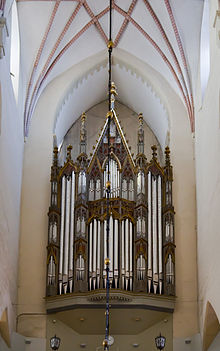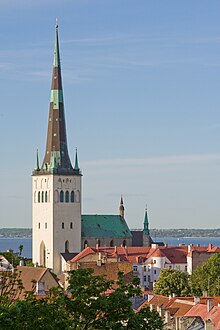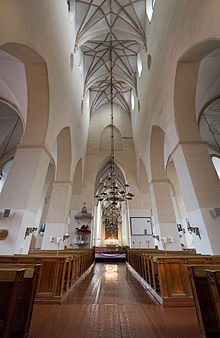Olaikirche
The Olaikirche (Estonian Oleviste kirik ) in Tallinn , Estonia , is a church in the north of the old town. The church is named after the Norwegian King Olav II. Haraldsson , who is regarded as a protector of seafarers.
history
The oldest mention of the church is dated to 1267. At that time, the Danish Queen Margarete gave the Cistercian convent St. Michael zu Reval the parish rights to the Olaikirche. Little is known about the early years of this Gothic church, but it is believed that there was a church on the same site before the 12th century. Construction reports from the 14th and 15th centuries testify to the expansion of the church, and the tower is mentioned in 1364. In 1625 it was burned to rubble and ashes. The reconstruction was completed in 1649–1651 with the building of the tower, which was carried out under the direction of Hans Kohseler from Kulmbach. According to him, the tower reached a height of 444 feet, according to the Rhenish foot measurement , this is the equivalent of 139 m. In the course of this construction work, the four characteristic corner turrets, which are shown for the first time in 1663, were created. After another fire in the tower in 1820, it was rebuilt with support from the Tsar until 1834. The tower now reached 138.68 m.
The assertion made by various sources that the church was the tallest building in the world between 1549 and 1625 with an allegedly 159 meter high tower , is based on an error. In fact, according to new estimates, the height of the church tower, built in 1549, was 115 to 125 meters, i.e. similar to today's tower. With that the church tower was still high enough to serve as a signal for the seafarers. Thus, the Hanseatic city could be seen from afar at sea. However, a high tower also entailed risks: lightning struck the church tower at least eight times and the church burned down completely three times. The flames were seen even on the other side of the Gulf of Finland in Finland .
Heinrich Stiehl was organist at the Olaikirche from 1880 until his death in 1886 and performed Johann Sebastian Bach's St. Matthew Passion here for the first time in the Baltic States in 1883 .
The church is now a Baptist church .
View of the city from the tower of Olaikirche (May 2016)
organ

The organ was built by Friedrich Hermann Lütkemüller from 1840 to 1842 and set up by the Walcker organ building company with Johann Eberhard Walcker and three other assistants. From Lütkemüller's autobiography from 1869:
- “During the construction of the two large plants for St. Petersburg 1838–1840 and for Reval 1840–1842, my training progressed more and more so that during an eight-month absence from Walcker I could be entrusted with the management completely independently. Intonation and tuning of the Revaler organ was already my work. To set up the organ for the St. Olai Church in Reval, I went to Reval with three other assistants in addition to Mr. Walcker. "
- “The organ in the Olaikirche and an eight-legged work in the country were installed in four months. I also played another organ in Reval, which had been repaired by a local organ builder Tanton and for which work we had brought various new registers and which allowed me to do the whole tuning because I could do it more safely and better than him ... "
In 1914 it was converted. The instrument has 76 stops on three manuals and a pedal . The actions are pneumatic.
|
|
|
|
||||||||||||||||||||||||||||||||||||||||||||||||||||||||||||||||||||||||||||||||||||||||||||||||||||||||||||||||||||||||||||||||||||||||||||||||||||||||||||||||||||||||||||||||||||||||||||||||||||||||||||||||||
-
Couple:
- Normal coupling: II / I, III / I, III / II, I / P, II / P, III / P,
- Super octave coupling: II / I, II / II, III / I, III / II, III / III, II / P, III / P
- Sub-octave coupling: II / I, II / II, III / I, III / II, III / III, III / P
Individual evidence
- ^ Eugen von Nottbeck, Wilhelm Neumann: History and art monuments of the city of Reval. Reval 1896, pp. 101-108. Other sources give 123.7 m as the tower height. Heinrich WJ Rickers: Something about the St. Olai church in Reval, which was destroyed by a lightning bolt on the night of July 15th to 16th, 1820 . Reval 1820 (online at books.google), p. 16, reports on the fire of 1625, "Before the fire, the tower was 84 fathoms high ... now it was 10 fathoms shorter, so only 74 fathoms high." On p. 43 he puts the Olaiturm in the list of the tallest buildings in the world: "The Olaiturm has always had the reputation of being one of the tallest towers", it has been listed as the third or fifth tallest tower in Christianity. Richter (pp. 43–44) postulates that the traditional statement of 74 "fathers" height for the tower from 1651 actually means 74 "fathoms" of 6 Rhenish feet (31.385 cm, also known as Prussian feet since 1793) and so comes up 444 feet high (= 139 m). The historical tradition that the tower height was 84 fathoms before the fire of 1625 would have brought the height to 504 feet according to this calculation, which would have been the equivalent of 158 m and would have made the Olaikirchenturm the highest building in the world before 1625. Apart from the question of the credibility of the traditional measures, the conversion of the thread into Rhenish fathoms is also not valid.
- ^ Autobiography FH Lütkemüller. Copy owned by Schuke Orgelbau Potsdam.
- ↑ Information on the cathedral organ
literature
Eugen von Nottbeck, Wilhelm Neumann: History and art monuments of the city of Reval. Reval 1896, pp. 101-108. Online (The Internet Archive) Heinrich WJ Rickers: Something about the St. Olai Church in Reval, which was destroyed by a lightning bolt on the night of July 15th to 16th, 1820 . Reval 1820 (online at books.google)
See also
Web links
Coordinates: 59 ° 26 ′ 29.1 ″ N , 24 ° 44 ′ 52.1 ″ E





